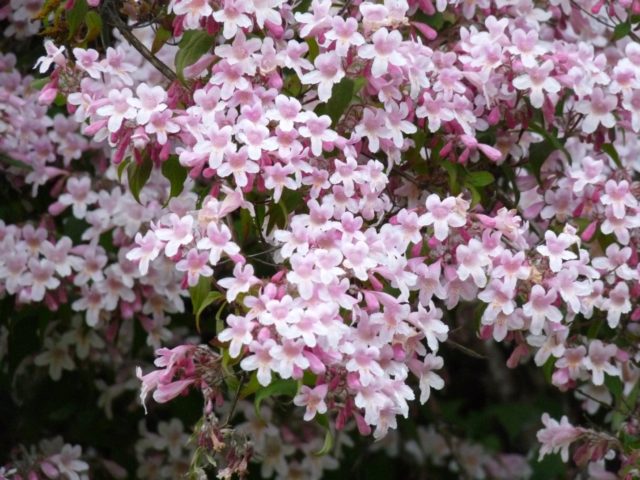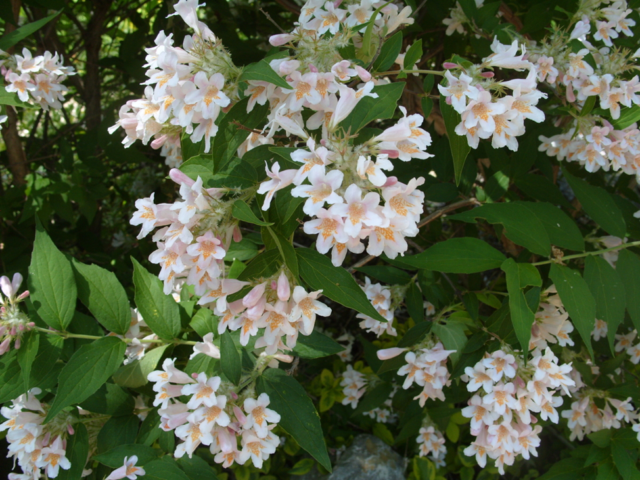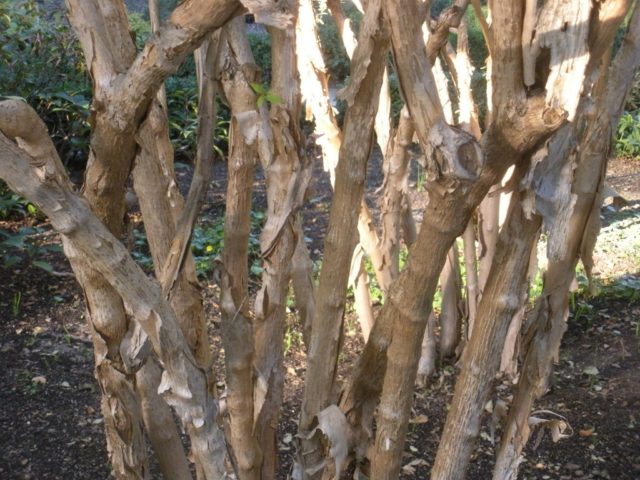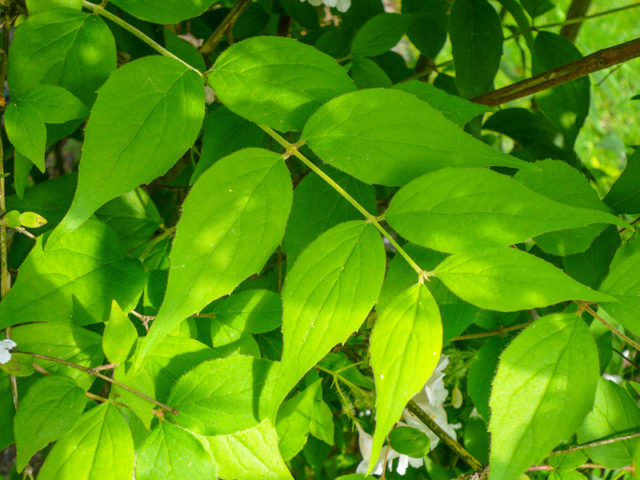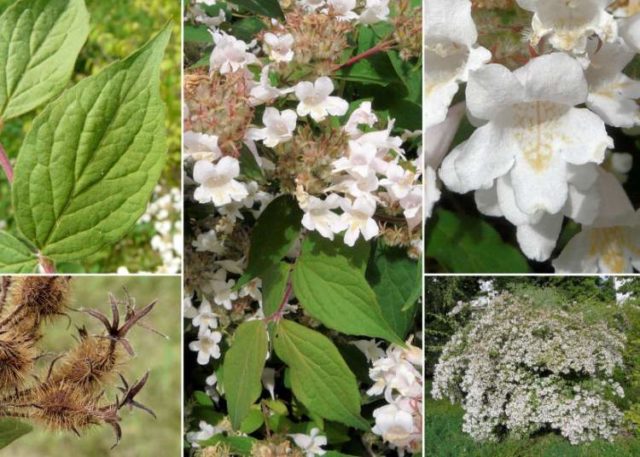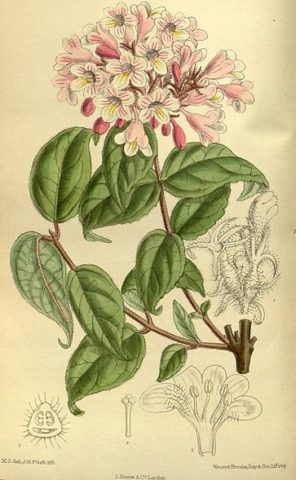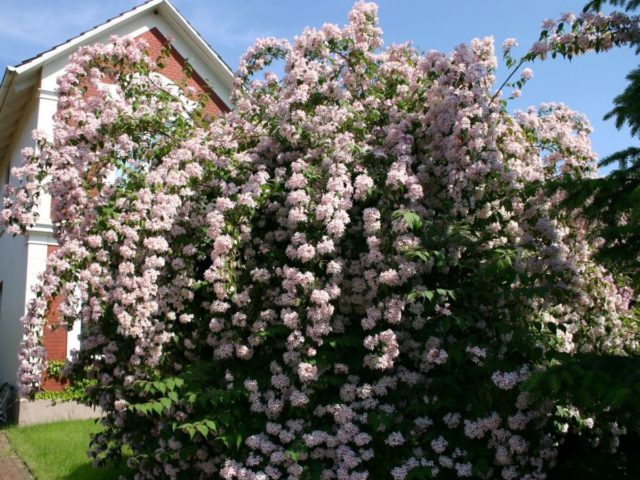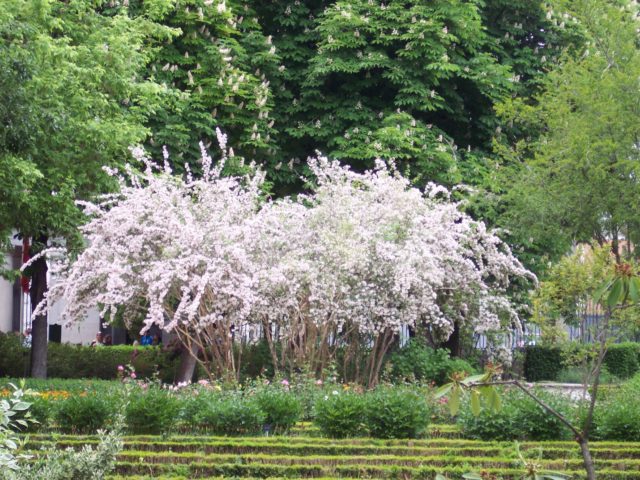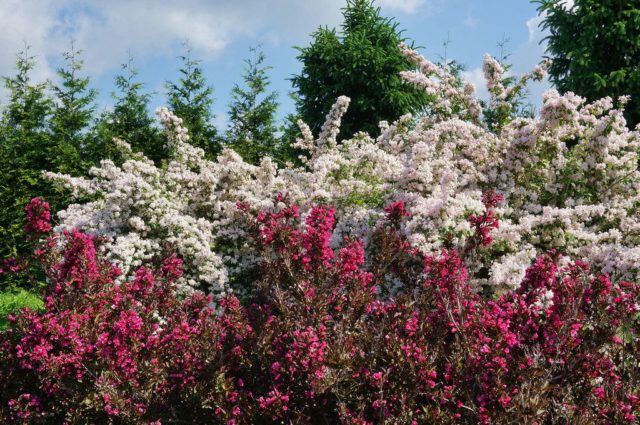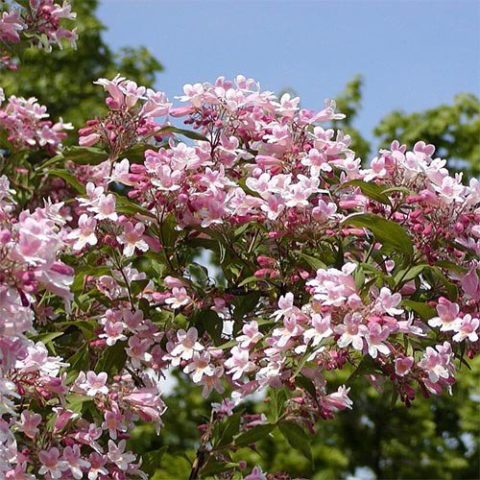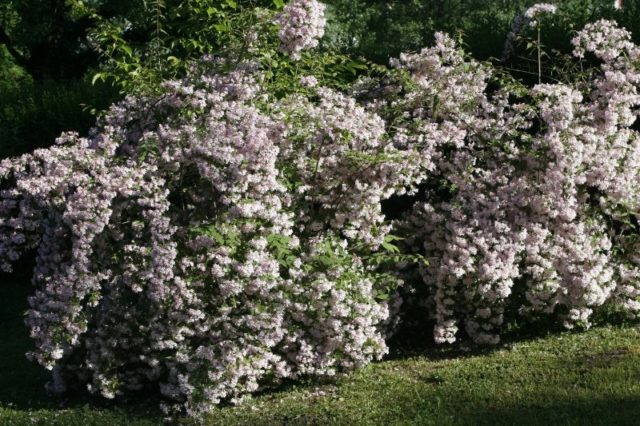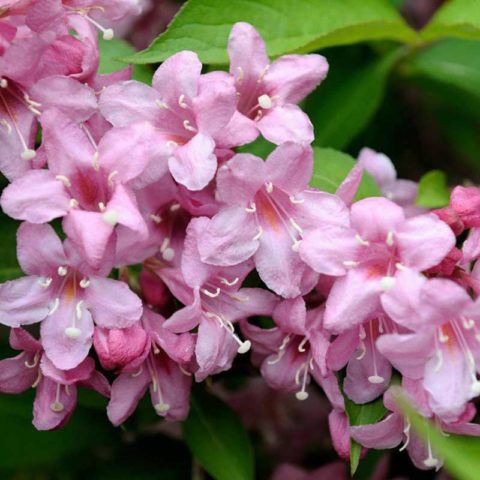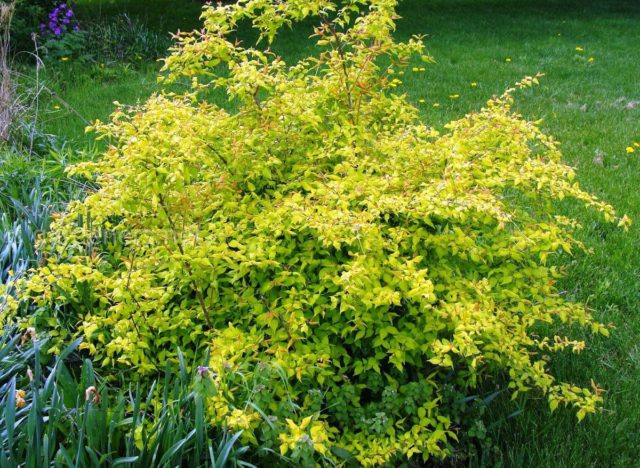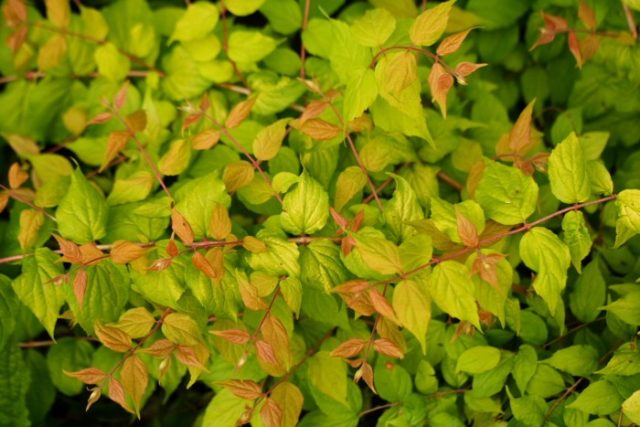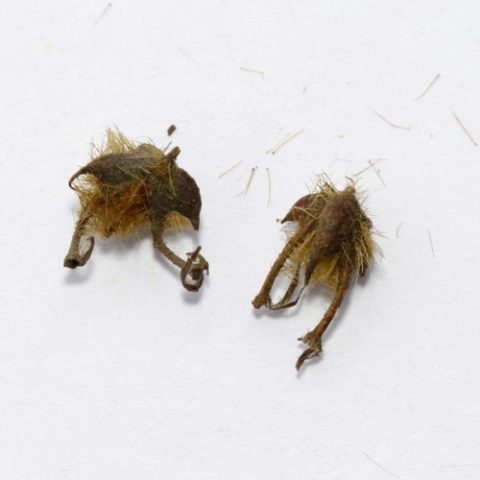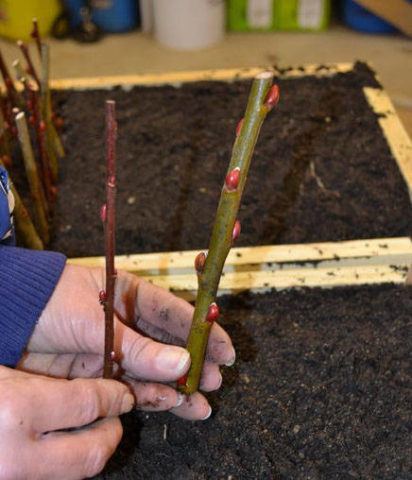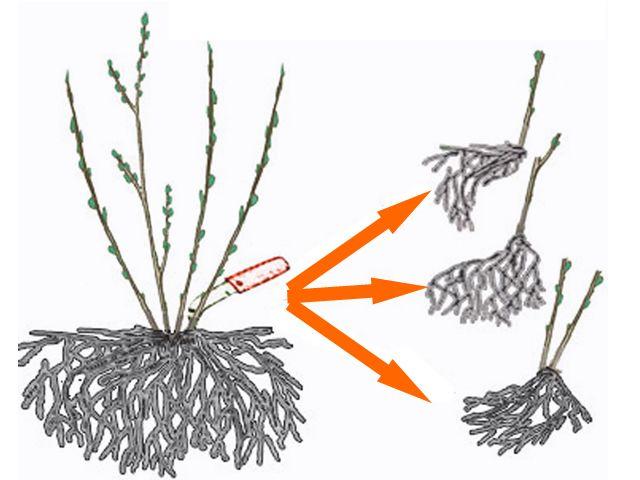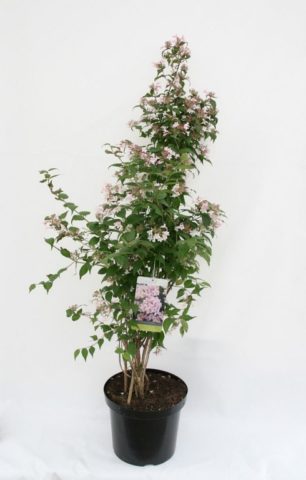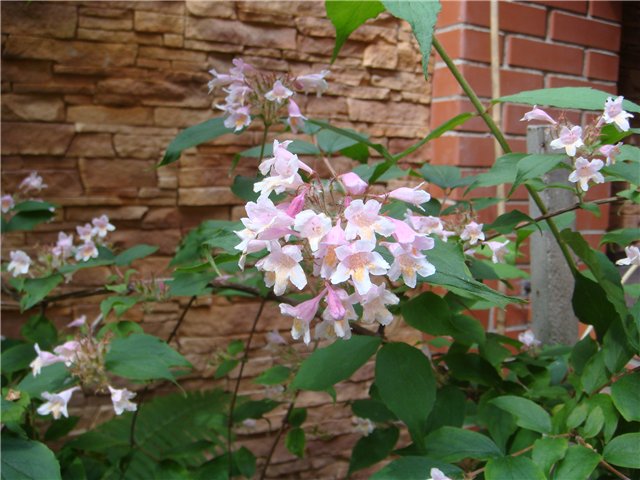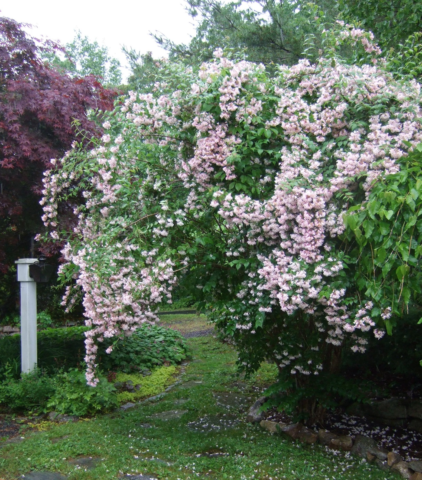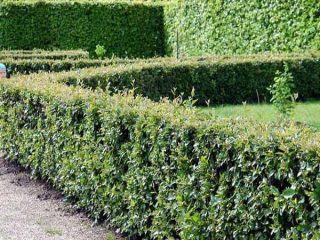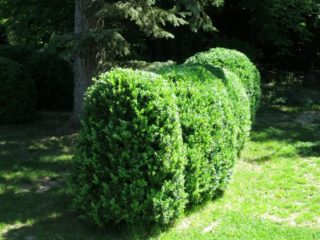Content
Kolkvitsia adorable is a deciduous ornamental shrub that is valued for its beautiful springtime appearance during the flowering period. Its main advantage is that, blooming in July, it creates a unique decor for a garden or a personal plot at a time when other plants have already faded. Culture looks great as a solitaire and as an element of landscape composition.
Description of flowering shrub kolquitia
Kolkwitzia amabilis is a monoecious (on which flowers of both sexes are placed) deciduous shrub of the Honeysuckle family. The homeland of the plant is Western China. It was brought to Europe over 100 years ago, but has not yet been widely used in landscape design. One of the names of the plant is pleasant colquitia.
The main species characteristics:
- A multi-stemmed shrub with a spherical crown and abundant root growth. Its height is up to 3 m, width - up to 4 m. A cultivated plant can be more compact - 1.5 - 2 m.
- At first, the straight branches, growing, bend in the form of an arch, leaning towards the ground under the weight of flowers.
- The bark of shoots of colquicia is lovely thin, reddish-brown, flakes off in plates.
- The wide leaves are oval, pointed towards the top. They are located opposite. Their length is 3 - 7 cm. Their edges are shaggy. In the upper part, the leaves are dark green in color, lightening towards the base. In autumn, they turn bright yellow and red.
- The flowers, about 1.5 cm in size, have a light aroma, are collected in corymbose inflorescences and are located at the ends of the shoots. Their shape is bell-shaped, five-bladed. The color of the beautiful colquitia flower is light pink with a lilac tint, inside the pharynx there is an orange pattern. Pedicels are omitted.
- Single-seeded fruits ripen by autumn. They are dry, covered with bristles and look like a brown box. They form seeds that are characterized by poor germination.
This description and specific features of the lovely colquation are detailed in the photo:
The shrub grows well and blooms profusely in any garden soil. For him, it is preferable to have a sunny spot, the culture feels good in partial shade. Kolkvitsiya adorable is characterized by the properties of frost resistance and endurance in an urban environment.
How and when colquitia blooms
Blooming colquia is lovely and looks very graceful. Its delicate pink flowers, reminiscent of mother-of-pearl, cascade on hanging branches. The flowering of the shrub is abundant: the foliage behind the flowers is almost invisible. They attract insects with their sweetish aroma.
The growing season of the plant is mid-April-November.The lovely colquicia blooms from the age of five in spring or summer, depending on the climate of the growing zone. In the middle lane, it blooms in early July, later than other ornamental shrubs. Flowering lasts more than three weeks.
Application in landscape design
According to experts in the field of landscape design, the charming colquction looks most advantageous as a tapeworm in various compositions:
- An accent element on a green lawn. The lovely kolkvitsiya are planted individually on a well-groomed area. When trimming, they give it a neat spherical or fountain shape.Advice! Kolkvitsiya adorable goes well with the texture of stone and dark wood.
- Group planting of a lovely colquition. A shrub planted in the form of a hedge looks spectacular. In this way, you can give privacy to the recreation area in the garden or the splendor of the central entrance of the personal plot. By combining different varieties of lovely colquitsia in a group planting, they create low-contrast color transitions from dark pink to almost white.
- Contrasting compositions. The light color of the flowers of the adorable colquitia is emphasized by darker deciduous, coniferous or brightly flowering plants. In autumn, its yellow or red foliage sets off less colorful shrubs. Vegaila and hawthorn emphasize the tenderness of the flowers of the culture.
- Mixborders. The delicate pink flowers of the lovely colquia highlight the central part of the shrub group. It is positioned as a tapeworm and is surrounded by lower plants.Important! A free-form flower bed is called a mixborder.
Varieties of wonderful colquation
There are few varieties of this plant. They are highly decorative. Heat-loving and not hardy enough, varieties of lovely colquitia require special conditions for planting and care. For cultivation in temperate continental climates of the middle zone, Pink Cloud, Rosea and Dreamcatcher varieties are suitable.
Pink Cloud
The Pink Cloud blooms more abundantly than the original colquitia cultivar. The shrub is smaller. At the age of five, it reaches a height of 0.8 m. Its maximum size is 2x2 m. The variety is frost-resistant and drought-resistant. Its shoots grow vertically, and the appearing pale pink flowers almost completely hide them.
Rosea or Rosea (Rosea)
Rosea begins to bloom with bright pink bells, which, as they bloom, acquire a light pink, almost white color. The shrub lends itself well to pruning. Perfect balls are formed from it, which are completely covered with flowers. The shoots of the culture hang down beautifully in the form of a fountain. In autumn, the leaves turn orange.
Dream Catcher Beauty Bush
A common name for this variety is Maradco. Its main difference from other varieties is the more compact size of the bush. The golden-orange hue of the leaves and the abundant flowering are another varietal feature of this charming colquation. The culture is also disease resistant.
Features of reproduction of colquitsia
The adorable kolquicia, like other perennial shrubs, is propagated by seeds, cuttings, layering or division.
Seeds
The seeds of the plant have a low germination rate - 25 - 35%, which must be taken into account when choosing this method of reproduction. With such a cultivation of the charming colquitia, special attention is paid to the nutrient substrate. It is made up of peat and sand, taken in equal proportions.
The seeds are planted in early April. To protect the shoots from late frosts, they are placed in a greenhouse or at home in a pot.The sprouts sprout by the beginning of summer, and in August they grow by almost 20 cm.
Procedure for reproduction of colquitia with adorable seeds:
- Prepare the seeds. For this, the seeds are subjected to stratification for two months: they are stored in a refrigerator at a temperature of 1 - 3 0C in an airtight bag with damp vermiculite or tissue. To accelerate germination, the seed is soaked for 10 minutes. in sulfuric acid.
- Deepen the seeds into the substrate by no more than 0.5 cm and spill abundantly.
- The next spring after planting, it is important to dive the plant and plant it in a permanent place.
Layers
The most effective way to reproduce a lovely colquition is by layering. The sequence of actions is as follows:
- A coppice shoot growing outward of the bush is chosen.
- A small groove is dug under it.
- The shoot is tilted and placed in a groove.
- At the point where the shoot touches the ground, it is slightly incised and treated with a growth stimulant.
- The shoot is fixed with a hairpin and sprinkled with soil, leaving the top free.
- The soil is constantly kept slightly moist during the summer.
- The next spring, after rooting, the cuttings of the lovely colquicia are separated from the mother shrub and transplanted to a permanent place.
Cuttings
Cutting is carried out in one of the ways:
- Lignified cuttings. At the end of autumn, a lignified twig is cut off from a charming bush and is added dropwise in a shaded place. By winter, cuttings are mulched with hay, straw or foliage. With the arrival of spring, they are opened. Over the summer, the shoots will take shape and take root. The next spring, the young plant is transplanted to the desired location.
- Annual cuttings. In early spring, one-year-old shoots are separated from the mother bush and cuttings are cut. Then, for rooting, they are planted in containers with soil mixture and kept in a warm place. At the beginning of summer, the cuttings are taken outside in the shade and watered regularly, preventing the soil from drying out. After the appearance of young shoots, they are transplanted into open ground in a shaded place and continue to be watered. Before the onset of winter, the plants are covered. In the spring, a lovely young colquation is transplanted to a permanent site.
By dividing the bush
The method of reproduction by dividing the bush is advisable to use when transplanting a lovely colquitia. They do it this way:
- The plant is carefully dug up.
- A thorough examination of the root system is carried out. Rotten and dry roots are removed.
- The bush is divided into 3 - 4 parts so that each division consists of a healthy shoot and good roots.
- Sections are treated with garden varnish or sprinkled with crushed coal.
- New plants are planted in pre-prepared holes according to the scheme adopted for kolkvitiya.
Planting and caring for kolkvitiya in the open field
Cultivation of kolkvitsii in the middle lane, in the south of Russia and in the Moscow region requires adherence to the rules of planting and caring for the plant. Agrotechnical measures for this culture are not difficult and are available even to novice gardeners.
Recommended timing
It is recommended to plant the lovely kolquicia in open ground in the spring, when the soil in the root layer warms up well:
- end of March - for the southern regions;
- early April - for the middle lane;
- mid-end of April - for the Moscow region and territories located to the north.
Site selection and soil preparation
The place for planting a lovely colquition must meet the characteristics:
- be well lit, but openwork partial shade is allowed;Important! In the shade, colquitia blooms sparsely.
- protected from gusts of wind (for example, against a wall of a building or a fence);
- groundwater should not run too high, stagnation of rain or snow water is not allowed;
- the shrub grows well and blooms on fertile, loose and weed-free soil: ideally, it should contain humus, sand, compost and leafy soil.
How to plant a lovely colquition
For planting, choose one- or two-year-old healthy seedlings with well-developed roots. In order for the adorable colquction, regardless of the selected variety, to take root well and bloom thickly, adhere to the following planting algorithm:
- Prepare a hole 60x60x60 cm in size.When group planting, the distance between the bushes should not be less than 1.5 m.
- Pour a fertile mixture of earth, humus and sand at the bottom of the pit in a ratio of 2: 1: 1.
- Install a sapling of a lovely colquitium in the hole, making sure that its root collar is not buried.
- Spread the roots of the plant.
- By adding soil in portions and watering each layer with a small amount of water, fill the planting hole.
- Lightly tamp the trunk circle.
- The final stage of planting is watering and mulching the soil around the seedling.
How to plant kolkvitsiya in the suburbs
The order of planting the lovely colquity in the Moscow region and the Moscow region does not differ from the generally accepted scheme. Prepared seedlings are placed in holes, sprinkled with earth and watered. The soil must be mulched. This helps to retain soil moisture and keeps the roots from overheating.
Colquitia transplant
An overgrown shrub can be transplanted every five to six years to a new location. This is best done in the spring when the air temperature has stabilized. So the plant will root well and give young shoots. Kolkvitsiya adorable tolerates transplanting to a new place well. It takes root quickly and blooms well. At this time, you can propagate the bush by dividing. Algorithm for transplanting an adult plant or seedling with a closed root system:
- The shrub is carefully dug up or removed from the container, taking care not to damage its roots.
- A planting hole is prepared with a size exceeding the dimensions of the root system with an earthen clod.
- Pour a nutrient-rich soil mixture into the hole.
- The bush is placed in a planting nest, its roots are covered with earth, avoiding deepening the root collar. The soil is compacted.
- The transplanted colquitia requires abundant watering and mulching of the trunk circle.
Growing features
Kolkvitsiya adorable is able to withstand frosts down to -15 0C. According to the reviews of domestic gardeners, she is not afraid of short-term frost down to -30 0FROM.
Watering and feeding schedule
The adorable kolquitsia withstands a short drought, but for good flowering and development, it needs regular watering. Water the bush, preventing the soil from drying out, while using water that is settled and warmed up in the sun. The best time for the procedure is evening.
An excess of fertilizers reduces the winter hardiness of the plant and activates growth processes, which lead to a deterioration in the flowering of the shrub. Top dressing is applied according to the following schedule:
- with rotted organic matter and mineral additives, the culture is fertilized 2 - 3 times during the growing season;
- if the plant develops poorly, use liquid top dressing in the form of superphosphate (40 g per bucket of water) or mullein infusion (1:10).
Nutrient mixture consumption - 10 liters per bush.
Pruning kolkvitsiya
The adorable colquitia needs gentle, formative pruning. They try not to cut the lateral and upper branches, as this can negatively affect the flowering of the shrub. In summer, the unripe tops of the shoots are shortened, which helps to strengthen their bases.
Rejuvenating pruning is carried out after the lovely colquia has faded. Old shoots are cut under the base. Since spring, the plant will direct all its forces to form the growth of young branches. They will start blooming next year.
Sanitary pruning is carried out with the onset of spring. At the same time, branches damaged by frost and pests are removed.
How to cover a colquation for the winter
Successful wintering of the charming colquia, especially in the middle lane and the Moscow region, as well as in areas with severe frosts, is possible only with proper preparation. It begins in the fall, without waiting for early frosts:
- reducing watering of the bush;
- stopping fertilizing after flowering;
- mulching for the winter the root zone of the leaf, compost with sawdust or peat, while laying a layer with a thickness of at least 5 - 10 cm, which protects the soil from freezing.
The best protection of a plant from frost is its shelter for the winter. The crown of young plants is wrapped with non-woven covering materials or kraft paper. Effectively bending the shrub to the ground, followed by laying spruce branches on it. Then a layer of snow up to 30 cm thick is thrown on top, under which the plant will safely overwinter. With the onset of heat, the lovely colquation must be freed from the covering materials in order to prevent it from becoming rotten.
It is possible to grow a blooming, healthy, disease-resistant shrub, as in the photo, only with proper planting and competent care of the colquitia.
Pests and diseases
The shrub has disease and pest resistance properties. But in dry and hot weather, it can be attacked by spider mites, thrips, aphids and caterpillars. In this case, the crown is treated with a solution of insecticides for flowering plants.
The following problems may arise when growing a plant:
Problem | Cause | Recommendations for elimination |
Bad bloom | Insufficient illumination. | Remove shading objects or replant a bush. |
Improper use of fertilizers. | Correct the feeding scheme. | |
Low soil nutritional value. | Fertilize the bush. | |
Dying off of young shoots | Freezing of a plant in winter. | · Remove damaged branches; · For the winter, the bushes must be covered. |
Decay of the root system | Stagnation of moisture in the soil. | Make drainage. |
Conclusion
The charming colquizia is a spectacular element of a modern well-kept garden. It is frost-resistant and almost not susceptible to diseases and insect attacks. The shrub is not difficult to grow in areas with a temperate continental climate: it is enough to carry out regular watering, pruning and feeding. To protect against freezing for the winter, the plant is covered.
